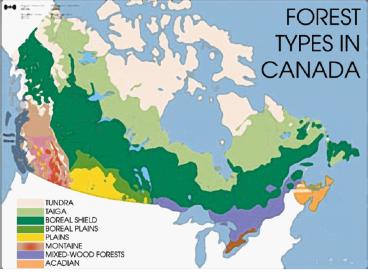Tundra - PowerPoint PPT Presentation
1 / 9
Title:
Tundra
Description:
Tundra. Coldest biome. Growing season short. Simple vegetation that can resist ... Often called the 'spruce-moose' biome. Located: S. Canadian Shield, Northern ... – PowerPoint PPT presentation
Number of Views:51
Avg rating:3.0/5.0
Title: Tundra
1
(No Transcript)
2
Tundra
- Coldest biome.
- Growing season short.
- Simple vegetation that can resist climate Low
shrubs, sedges, moss, grasses and flowers - Soil takes a long time to form.
- Located Arctic NorthLinks http//www.thecultur
edtraveler.com/archives/JUN2004/Tundra.htm - http//www.ucmp.berkeley.edu/exhibits/biomes/tundr
a.php
3
Taiga Forest
- Harsh continental climate
- Large temperature range between summer and winter
- Long winters
- Low precipitation
- Poor soil
- Closely-spaced trees and mossy ground cover.
- Larch, spruce, fir and pine coniferous
treesLocated Canadian ShieldLinks
http//en.wikipedia.org/wiki/Taiga - http//www.pfc.forestry.ca/canforest/canf/taiga1_e
.html
4
Boreal Forest
- Occupies 77 of Canada's total forest land.
- South of the taiga forest, but very similar.
- Sweeps across North America.
- Lots of coniferous trees.
- Often called the spruce-moose biome.
- Located S. Canadian Shield, Northern
PrairiesLinks http//www.borealforest.org/index.
php?categoryworld_boreal_forestpageoverview
5
Plains
- 95 of the plains has been converted to farmland.
- Alteration of natural habitat has meant more
endangered species on the prairies than anywhere
else. - Located Prairies
- Links http//canadianbiodiversity.mcgill.ca/engli
sh/ecozones/prairies/prairies.htm
6
Montaine
- BC has several forest zones due to its
fluctuation mountain climate. On the coast,
there is a coastal rainforest in the mountains,
a montaine climate. - Older forests mostly coniferous, younger forests
are mixed. - Due to the varying altitude (height) of the land,
there is a mix of alpine, tundra, and taiga
forest. - Located British Columbia, Western Alberta
7
Coastal Temperate
- Lots of mountains, leading to lots and lots of
orthographic rain... leading to really really
big, really really old trees. - Rarest ecosystem in the world (.02 of earth
surface) - Mix of deciduous and coniferous forests in some
areas, but oldest areas are deciduous. - Trees are so big that almost nothing can grow on
the floor due to no sunlight. - Located Pacific Coast
8
Mixedwood
- Less than 3 of this forest remains.
- Urbanization and agriculture have reduced the
ancient forests. - There was a mix of coniferous and deciduous
trees, with MANY native coniferous trees. - Lots of good soil and water.
- Located Great Lakes/St. Lawrence River
regionLinks http//canadianbiodiversity.mcgill.c
a/english/ecozones/mixedwoodplains/mixedwoodplains
.htm - http//cnfi.cfs.nrcan.gc.ca/canforest/canf/mixedwo
od4_e.html
9
Atlantic Maritime
- Most of this forest is gone after centuries of
farming. - Inhospitable highlands make for acidic soil. Poor
for farming but decent for forests. - More storms than anywhere else in the country.
Lots of precipitation. - Almost all of this forest has been logged at
least once, meaning no really old trees. - A tree disease killed off most of the chestnut
trees in the 20th century.

